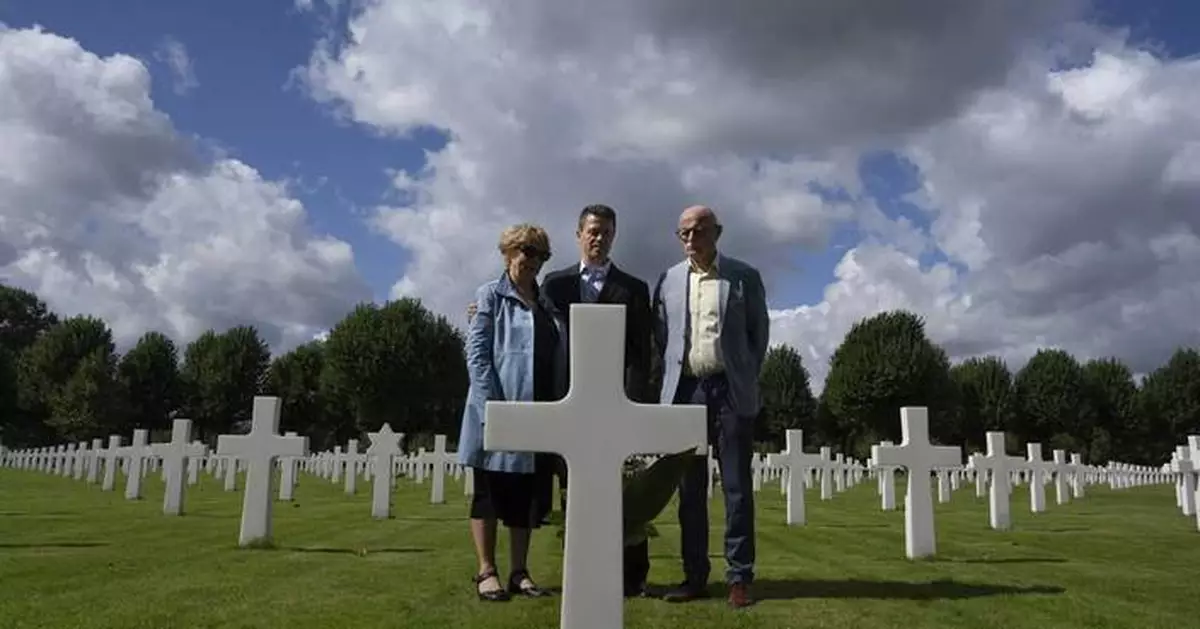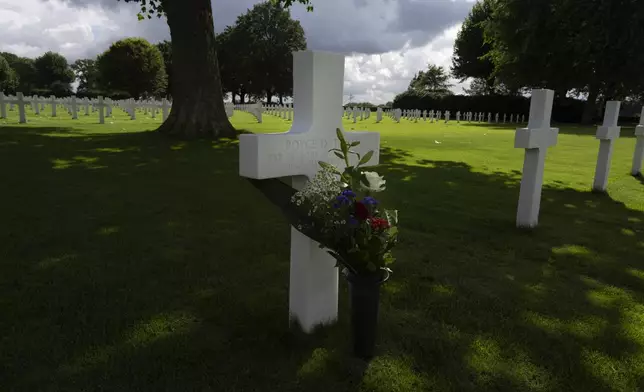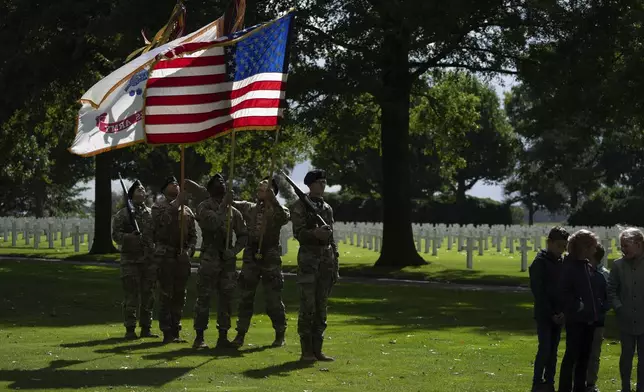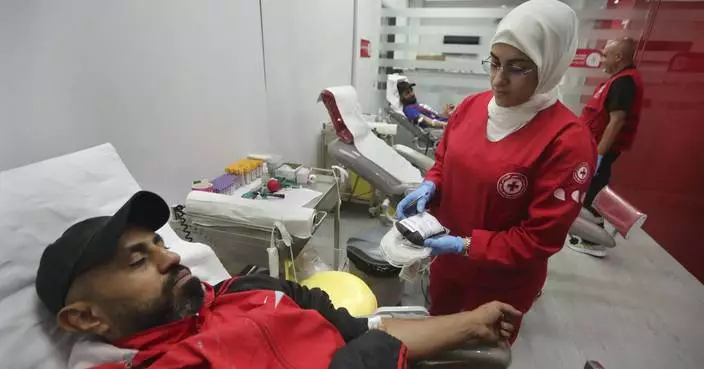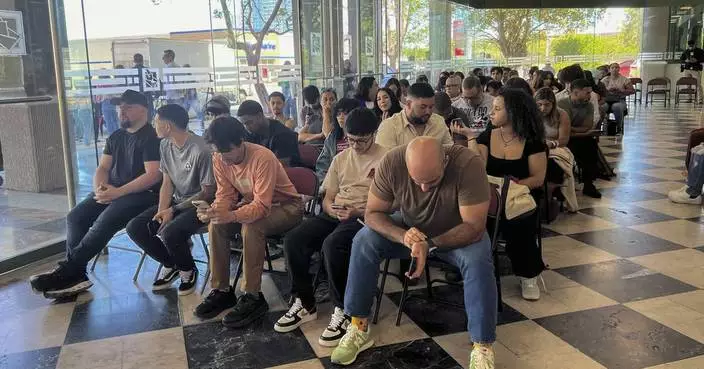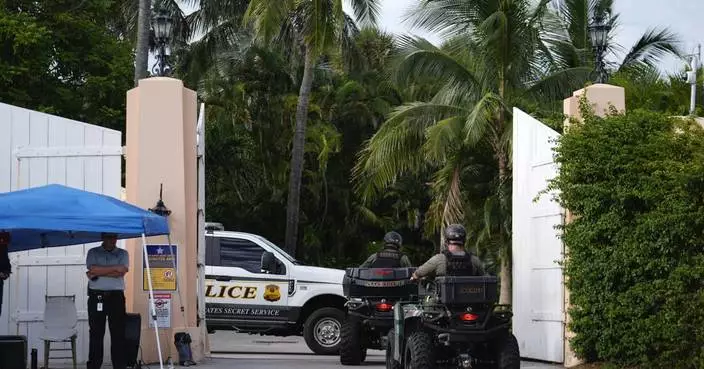MARGRATEN, Netherlands (AP) — In the rolling hills of the southern Netherlands, locals have vowed to never forget the American and other Allied soldiers who gave their lives in the fight to liberate towns and villages from the Nazi occupation in World War II.
Nowhere is the deep-rooted gratitude of the post-war generations more clear than in the 65.5 acres of manicured lawns and white marble headstones of the Netherlands American Cemetery on a hill just outside the village of Margraten.
Click to Gallery
Eighty years after the liberation of the south of the Netherlands, Scott Taylor, right, Ton Hermes, center, and Maria Kleijnen stand next to the grave of Scott's grandfather Second Lt. Royce Taylor, a bombardier with the 527 Bomb Squadron, at the Netherlands American Cemetery in Margraten, southern Netherlands, on Wednesday, Sept. 11, 2024. (AP Photo/Peter Dejong)
Eighty years after the liberation of the south of the Netherlands, Scott Taylor, left, Ton Hermes, center, and Maria Kleijnen, left, talk as they look at a picture of Scott's grandfather Second Lt. Royce Taylor, a bombardier with the 527 Bomb Squadron, at the Netherlands American Cemetery in Margraten, southern Netherlands, on Wednesday, Sept. 11, 2024. (AP Photo/Peter Dejong)
Eighty years after the liberation of the south of the Netherlands a white rose was put at the grave of Hyman Ackerman, a technician 5th grade with the 411th Quartermaster Company, 17th Airborne Division, who died on March 24, 1945, stands among the 8,288 crosses and Star of David headstones at the Netherlands American Cemetery in Margraten, southern Netherlands, on Wednesday, Sept. 11, 2024. (AP Photo/Peter Dejong)
Eighty years after the liberation of the south of the Netherlands, Scott Taylor, right, Ton Hermes, center, and Maria Kleijnen, left, walk to the grave of Scott's grandfather Second Lt. Royce Taylor, a bombardier with the 527 Bomb Squadron, at the Netherlands American Cemetery in Margraten, southern Netherlands, on Wednesday, Sept. 11, 2024. (AP Photo/Peter Dejong)
Eighty years after the liberation of the south of the Netherlands, Scott Taylor, left, Ton Hermes, center, and Maria Kleijnen walk to the grave of Scott's grandfather Second Lt. Royce Taylor, a bombardier with the 527 Bomb Squadron, at the Netherlands American Cemetery in Margraten, southern Netherlands, on Wednesday, Sept. 11, 2024. (AP Photo/Peter Dejong)
MARGRATEN, Netherlands (AP) — In the rolling hills of the southern Netherlands, locals have vowed to never forget the American and other Allied soldiers who gave their lives in the fight to liberate towns and villages from the Nazi occupation in World War II.
Eighty years after the liberation of the south of the Netherlands, Scott Taylor, right, Ton Hermes, center, and Maria Kleijnen stand next to the grave of Scott's grandfather Second Lt. Royce Taylor, a bombardier with the 527 Bomb Squadron, at the Netherlands American Cemetery in Margraten, southern Netherlands, on Wednesday, Sept. 11, 2024. (AP Photo/Peter Dejong)
Eighty years after the liberation of the south of the Netherlands, Scott Taylor, left, Ton Hermes, center, and Maria Kleijnen, left, talk as they look at a picture of Scott's grandfather Second Lt. Royce Taylor, a bombardier with the 527 Bomb Squadron, at the Netherlands American Cemetery in Margraten, southern Netherlands, on Wednesday, Sept. 11, 2024. (AP Photo/Peter Dejong)
Eighty years after the liberation of the south of the Netherlands a white rose was put at the grave of Hyman Ackerman, a technician 5th grade with the 411th Quartermaster Company, 17th Airborne Division, who died on March 24, 1945, stands among the 8,288 crosses and Star of David headstones at the Netherlands American Cemetery in Margraten, southern Netherlands, on Wednesday, Sept. 11, 2024. (AP Photo/Peter Dejong)
Eighty years after the liberation of the south of the Netherlands Ton Hermes holds a picture of Second Lt. Royce Taylor, a bombardier with the 527 Bomb Squadron, next to his grave at the Netherlands American Cemetery in Margraten, southern Netherlands, on Wednesday, Sept. 11, 2024. (AP Photo/Peter Dejong)
Eighty years after the liberation of the south of the Netherlands the grave of Second Lt. Royce Taylor, a bombardier with the 527 Bomb Squadron, center, stands among the 8,288 crosses and Star of David headstones at the Netherlands American Cemetery in Margraten, southern Netherlands, on Wednesday, Sept. 11, 2024. (AP Photo/Peter Dejong)
Eighty years after the liberation of the south of the Netherlands the sun illuminates some of the 8,288 crosses and Star of David headstones at the Netherlands American Cemetery in Margraten, southern Netherlands, on Wednesday, Sept. 11, 2024. (AP Photo/Peter Dejong)
Eighty years after the liberation of the south of the Netherlands, Scott Taylor, right, Ton Hermes, center, and Maria Kleijnen, left, walk to the grave of Scott's grandfather Second Lt. Royce Taylor, a bombardier with the 527 Bomb Squadron, at the Netherlands American Cemetery in Margraten, southern Netherlands, on Wednesday, Sept. 11, 2024. (AP Photo/Peter Dejong)
Eighty years after the liberation of the south of the Netherlands a visitor pushes a stroller at the Netherlands American Cemetery in Margraten, southern Netherlands, on Wednesday, Sept. 11, 2024. (AP Photo/Peter Dejong)
Eighty years after the liberation of the south of the Netherlands the grave of Second Lt. Royce Taylor, a bombardier with the 527 Bomb Squadron, center, stands among the 8,288 crosses and Star of David headstones at the Netherlands American Cemetery in Margraten, southern Netherlands, on Wednesday, Sept. 11, 2024. (AP Photo/Peter Dejong)
Flag bearers of the the 101st Airborne Division, known as Screaming Eagles, out of Fort Campbell, Kentucky, rehearse for a commemoration eighty years after the liberation of the south of the Netherlands at the Netherlands American Cemetery in Margraten, southern Netherlands, on Wednesday, Sept. 11, 2024. (AP Photo/Peter Dejong)
Eighty years after the liberation of the south of the Netherlands, Scott Taylor, left, Ton Hermes, center, and Maria Kleijnen walk to the grave of Scott's grandfather Second Lt. Royce Taylor, a bombardier with the 527 Bomb Squadron, at the Netherlands American Cemetery in Margraten, southern Netherlands, on Wednesday, Sept. 11, 2024. (AP Photo/Peter Dejong)
Eighty years after the liberation of the south of the Netherlands, Scott Taylor, center, Ton Hermes and Maria Kleijnen stand next to the grave of Scott's grandfather Second Lt. Royce Taylor, a bombardier with the 527 Bomb Squadron, at the Netherlands American Cemetery in Margraten, southern Netherlands, on Wednesday, Sept. 11, 2024. (AP Photo/Peter Dejong)
The hallowed burial ground is hosting a concert Thursday to mark the 80th anniversary of the start of the liberation of the Netherlands.
Hundreds of people like Ton Hermes and Maria Kleijnen have chosen to “adopt” one of the 8,288 Americans buried there.
It’s an act of gratitude and remembrance that started almost as soon as the war ended and endures to this day.
People who adopt a grave visit it regularly and leave flowers on the fallen soldier’s birthday, the day they died, at Christmas, on Memorial Day or whenever else they see fit. Some reach out to families of the dead in the U.S., forming lasting transatlantic friendships.
Hermes and Kleijnen adopted 2nd Lt. Royce D. Taylor, a bombardier with the 527 Bomb Squadron, 379 heavy bomber group, who was killed at age 23 when his B-17 plane was shot down on his third mission over Germany — a raid to Bremen — on Dec. 20, 1943.
Taylor's grandson, Scott Taylor, from Indianapolis, calls his grandfather his hero. He is also the inspiration behind Scott's decision to serve in the U.S. Air Force. He flew F-15E Strike Eagle jets over Iraq and Kosovo.
Taylor paid tribute to Maria and to Ton, who chairs the foundation responsible for the adoptions, and all the families who tend graves in the cemetery that is meticulously maintained by the American Battle Monuments Commission.
"I’m very grateful. I can’t say it enough to Ton and Maria that I really am grateful for their efforts to be able to remember my grandfather and then also help other Dutch families to remember the others that are here in the cemetery,” he told The Associated Press as a cool fall wind blew through the rows of headstones.
“I am so grateful at a personal level ... because I can’t care for my grandfather like they can,” he added, after they had placed a fresh bouquet of flowers in front of Taylor's grave.
He was visiting the cemetery a day ahead of the concert to mark the 80th anniversary of American forces from the 30th Infantry Division, known as Old Hickory, crossing from nearby Belgium into the village of Mesch in what is remembered as the start of the liberation of the Netherlands from four years of brutal Nazi occupation.
While much of the south was quickly freed by Allied soldiers pushing eastwards into Germany, the far more densely populated west of the country, including major cities like Amsterdam and Rotterdam had to wait months for liberation.
Those months included a “hunger winter” when famine killed more than 20,000 Dutch people as a railroad strike was compounded by severe weather to prevent the movement of food and fuel. Some people resorted to eating tulip bulbs to survive.
Hermes, a retired Dutch soldier who served in Bosnia during the Balkan wars of the 1990s, said the timing of their visit to the cemetery on Wednesday — 9/11 — was a reminder of why people should keep alive memories of those who gave their lives for Dutch freedom from tyranny.
“It’s a day which shows that democracy and liberty is very fragile,” he said. “So that is why I think it’s important to adopt the grave and to think about what he did for our liberty. That democracy is vulnerable.”
Taylor agreed.
“It can’t be overstated. If we don’t take the opportunity to remember, then we lose the opportunity to understand the significance of their sacrifice,” Taylor said.
Without that remembrance, “we risk repeating those errors of evil and of occupation and of power and and all of those things ... that happened during World War II,” he added.
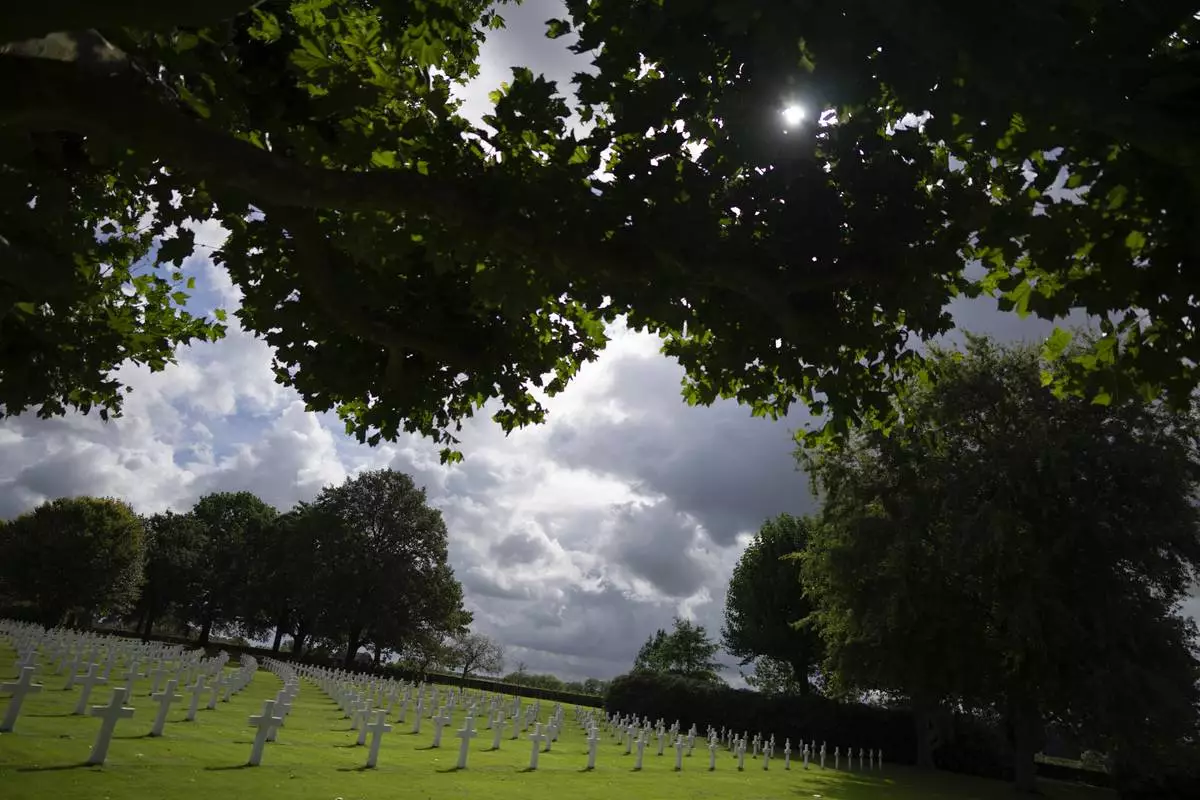
Eighty years after the liberation of the south of the Netherlands the sun illuminates some of the 8,288 crosses and Star of David headstones at the Netherlands American Cemetery in Margraten, southern Netherlands, on Wednesday, Sept. 11, 2024. (AP Photo/Peter Dejong)
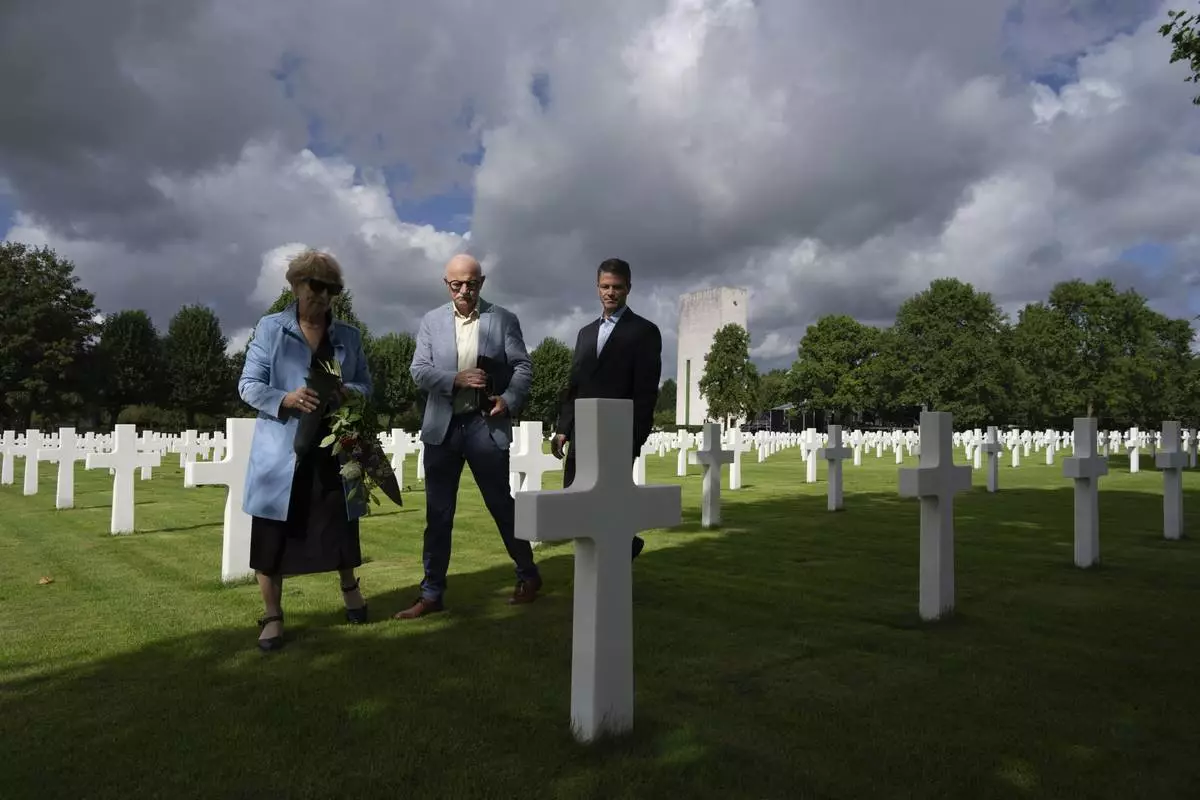
Eighty years after the liberation of the south of the Netherlands, Scott Taylor, right, Ton Hermes, center, and Maria Kleijnen stand next to the grave of Scott's grandfather Second Lt. Royce Taylor, a bombardier with the 527 Bomb Squadron, at the Netherlands American Cemetery in Margraten, southern Netherlands, on Wednesday, Sept. 11, 2024. (AP Photo/Peter Dejong)
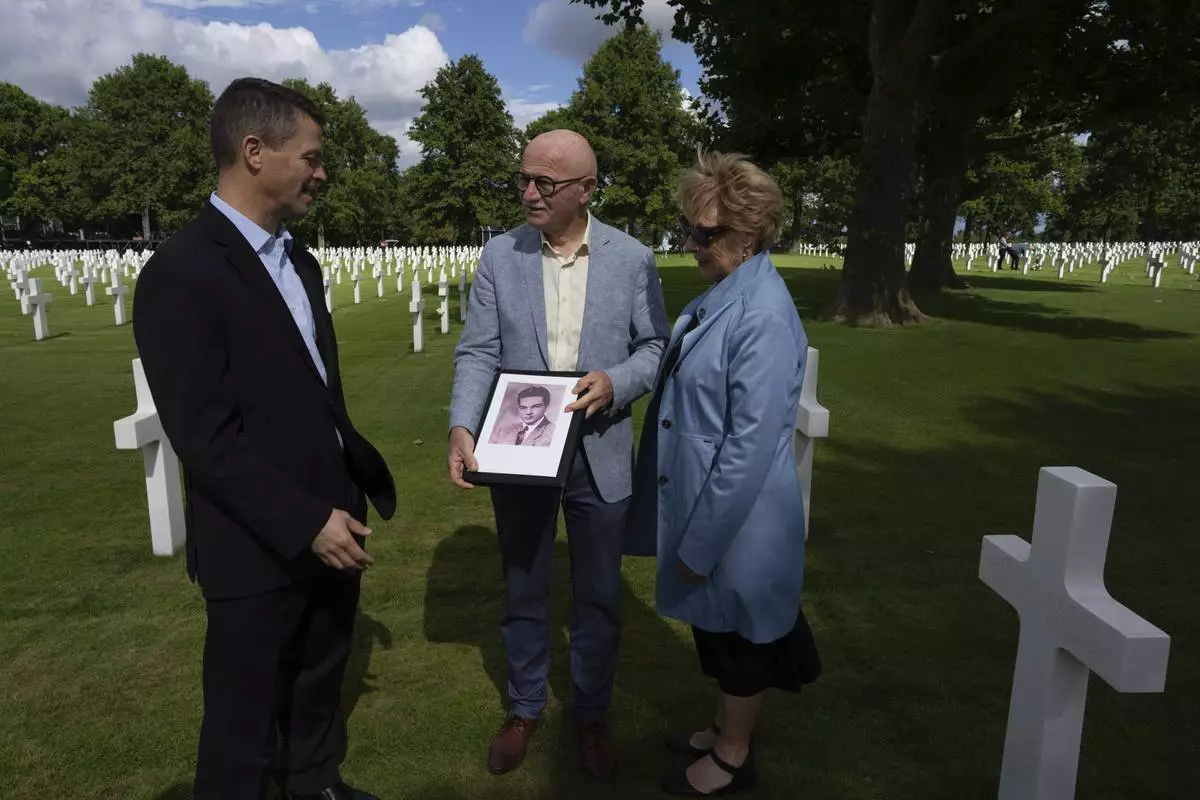
Eighty years after the liberation of the south of the Netherlands, Scott Taylor, left, Ton Hermes, center, and Maria Kleijnen, left, talk as they look at a picture of Scott's grandfather Second Lt. Royce Taylor, a bombardier with the 527 Bomb Squadron, at the Netherlands American Cemetery in Margraten, southern Netherlands, on Wednesday, Sept. 11, 2024. (AP Photo/Peter Dejong)
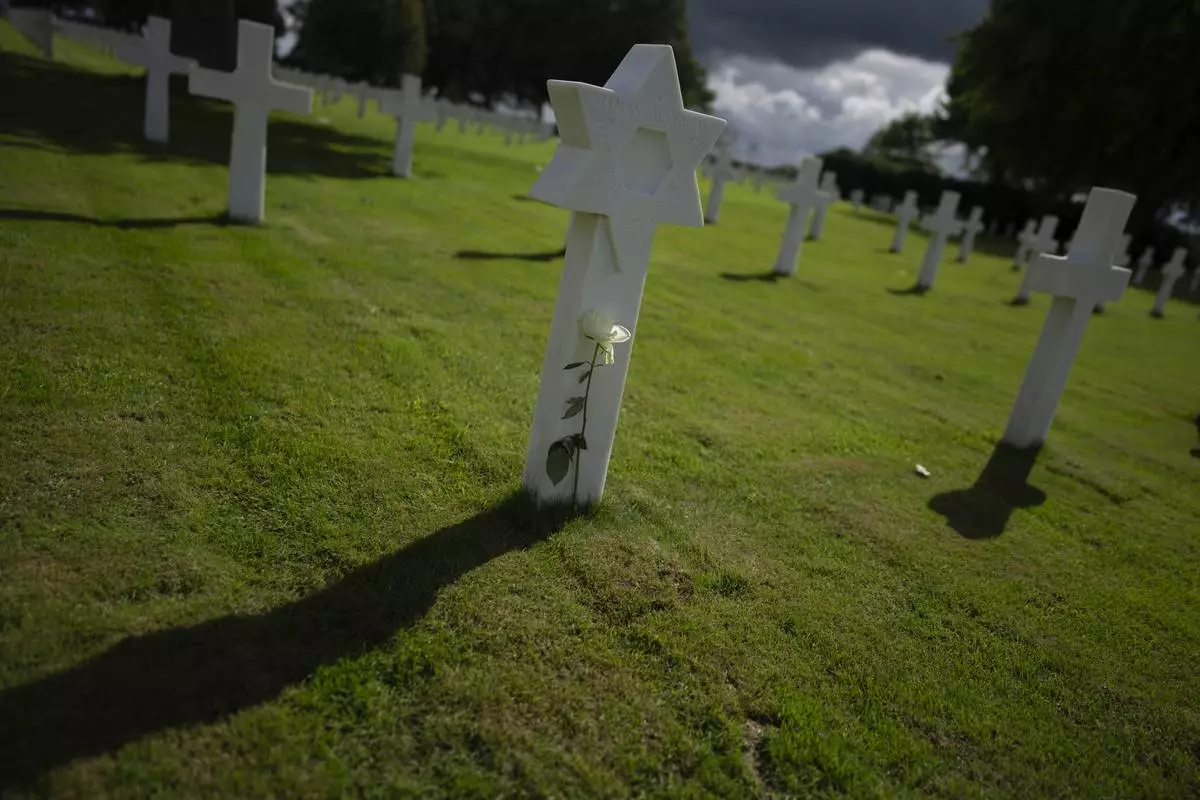
Eighty years after the liberation of the south of the Netherlands a white rose was put at the grave of Hyman Ackerman, a technician 5th grade with the 411th Quartermaster Company, 17th Airborne Division, who died on March 24, 1945, stands among the 8,288 crosses and Star of David headstones at the Netherlands American Cemetery in Margraten, southern Netherlands, on Wednesday, Sept. 11, 2024. (AP Photo/Peter Dejong)
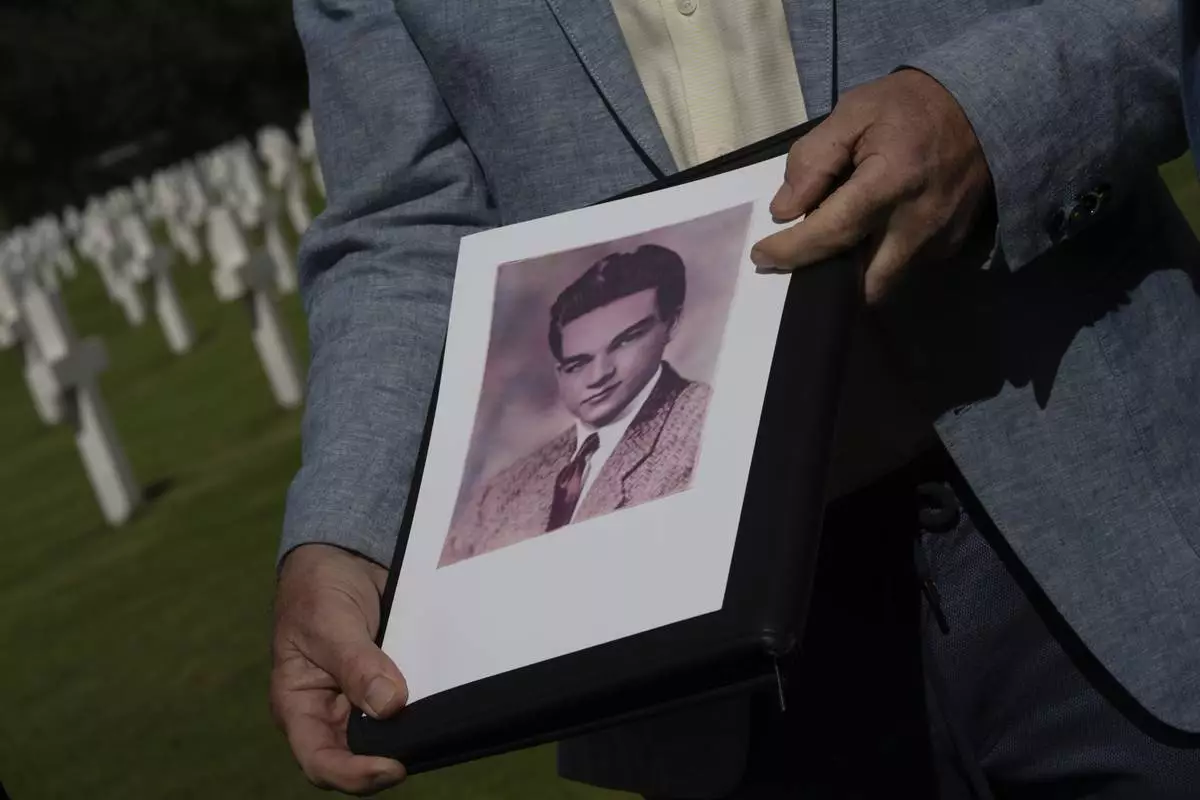
Eighty years after the liberation of the south of the Netherlands Ton Hermes holds a picture of Second Lt. Royce Taylor, a bombardier with the 527 Bomb Squadron, next to his grave at the Netherlands American Cemetery in Margraten, southern Netherlands, on Wednesday, Sept. 11, 2024. (AP Photo/Peter Dejong)
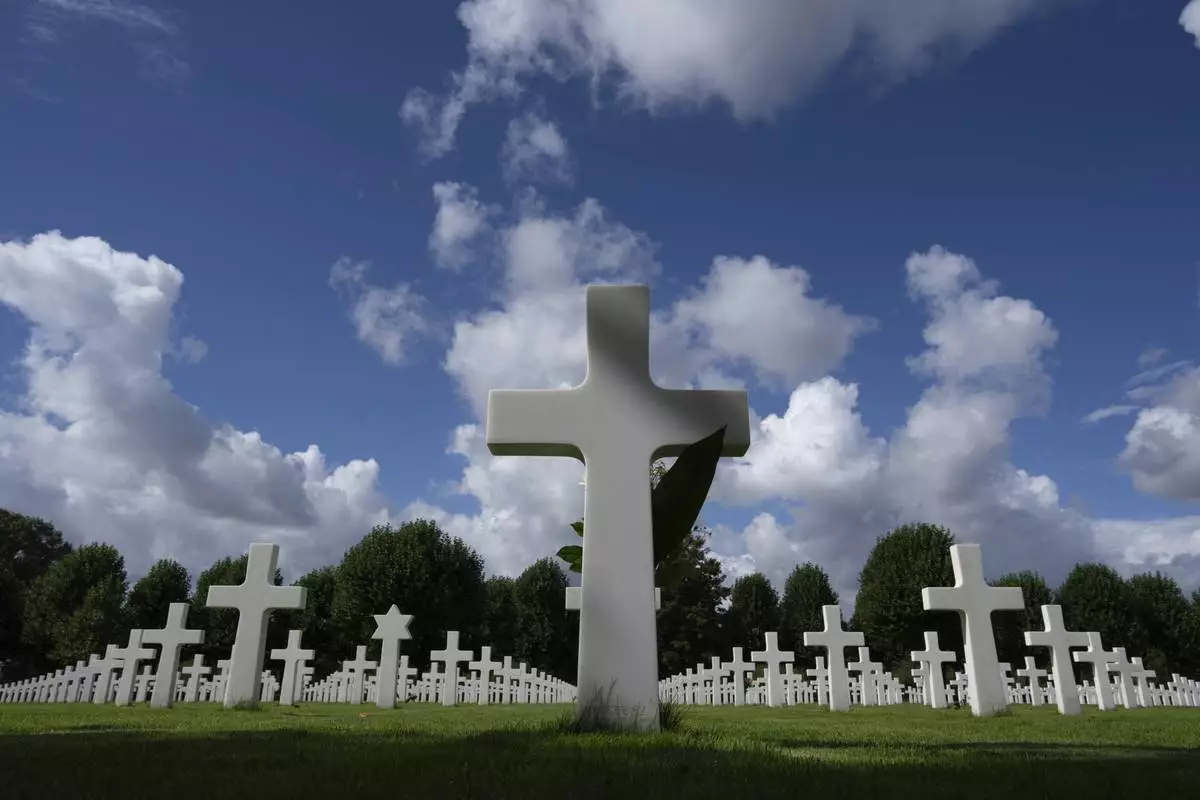
Eighty years after the liberation of the south of the Netherlands the grave of Second Lt. Royce Taylor, a bombardier with the 527 Bomb Squadron, center, stands among the 8,288 crosses and Star of David headstones at the Netherlands American Cemetery in Margraten, southern Netherlands, on Wednesday, Sept. 11, 2024. (AP Photo/Peter Dejong)
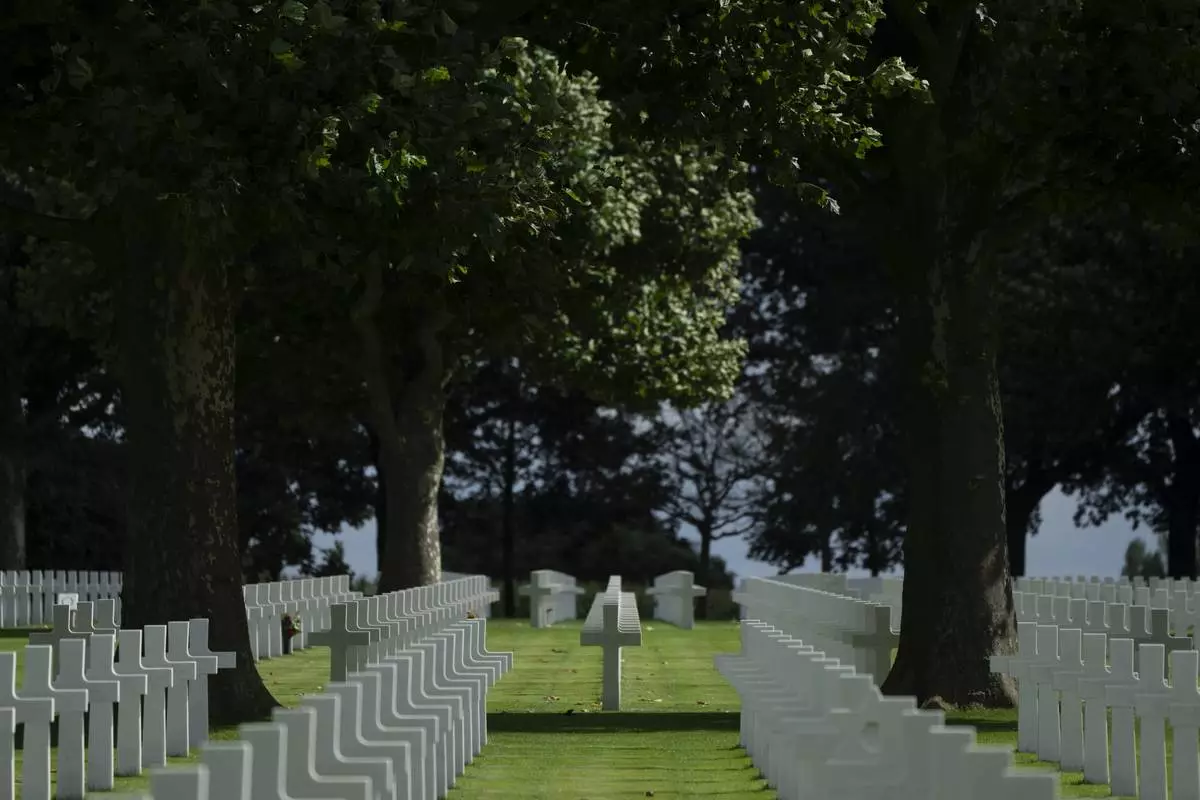
Eighty years after the liberation of the south of the Netherlands the sun illuminates some of the 8,288 crosses and Star of David headstones at the Netherlands American Cemetery in Margraten, southern Netherlands, on Wednesday, Sept. 11, 2024. (AP Photo/Peter Dejong)
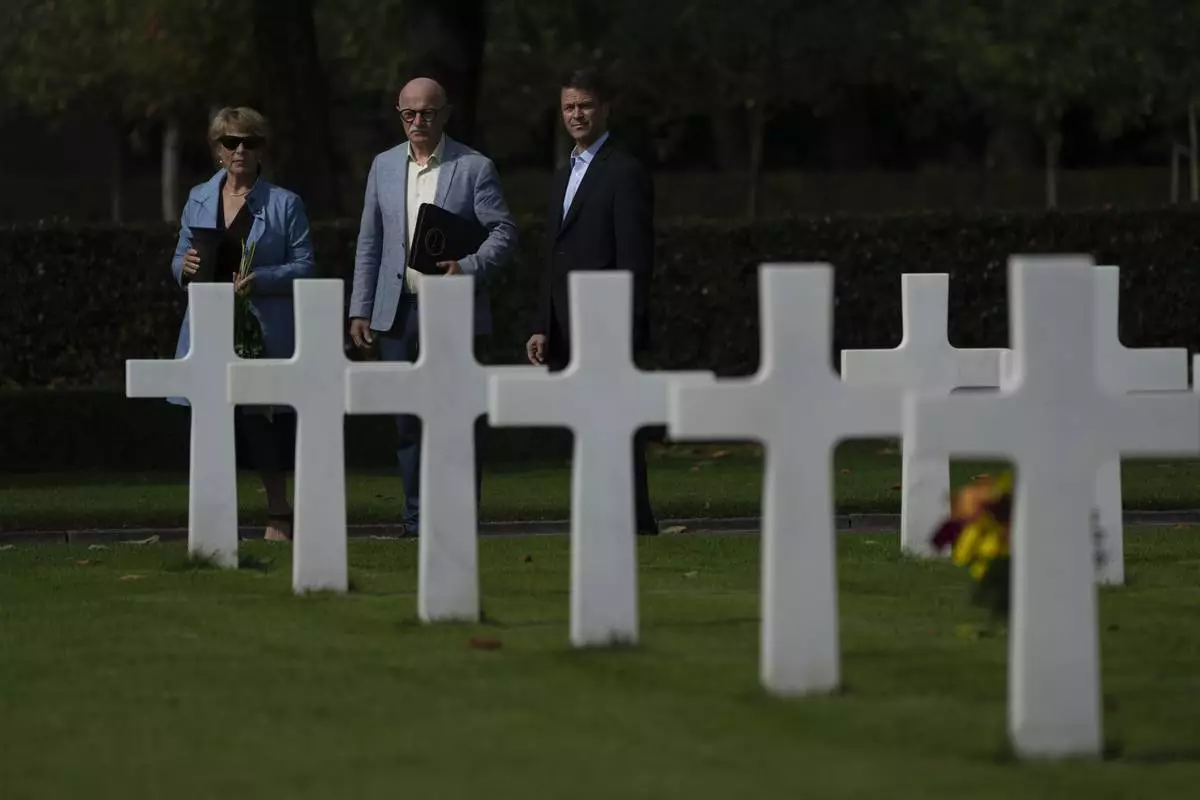
Eighty years after the liberation of the south of the Netherlands, Scott Taylor, right, Ton Hermes, center, and Maria Kleijnen, left, walk to the grave of Scott's grandfather Second Lt. Royce Taylor, a bombardier with the 527 Bomb Squadron, at the Netherlands American Cemetery in Margraten, southern Netherlands, on Wednesday, Sept. 11, 2024. (AP Photo/Peter Dejong)
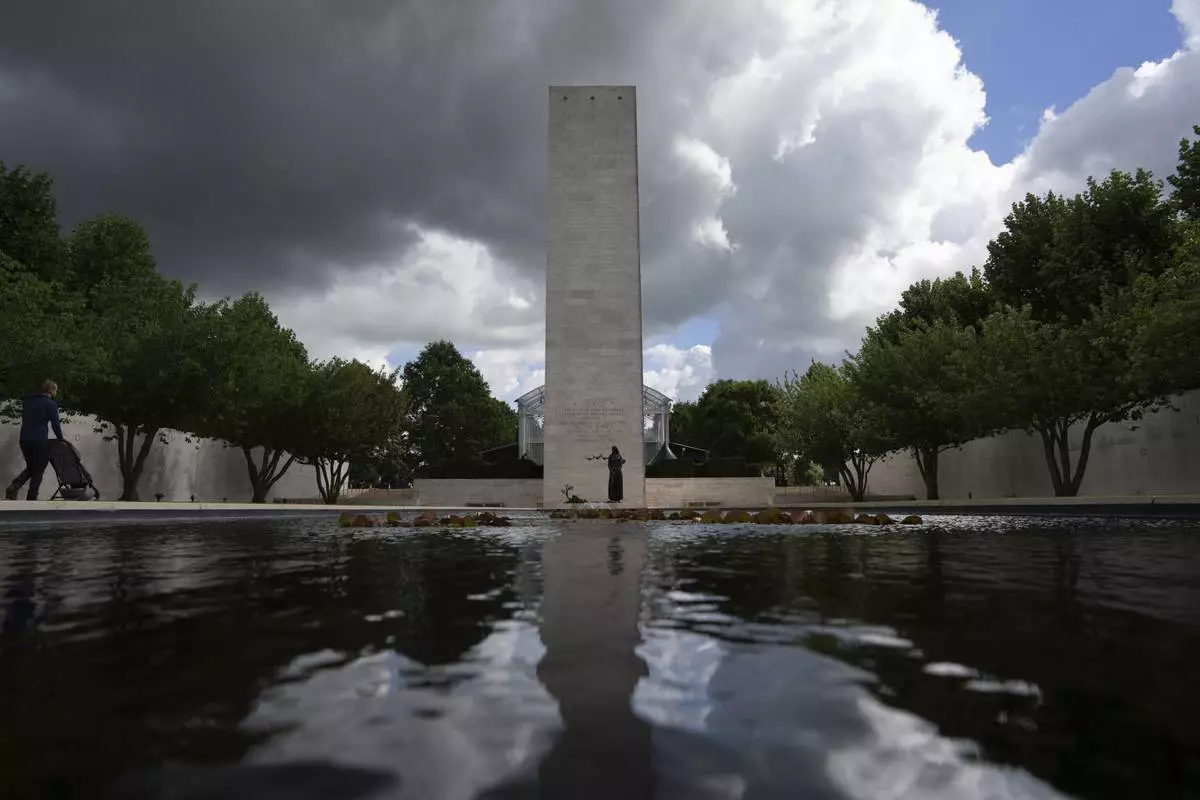
Eighty years after the liberation of the south of the Netherlands a visitor pushes a stroller at the Netherlands American Cemetery in Margraten, southern Netherlands, on Wednesday, Sept. 11, 2024. (AP Photo/Peter Dejong)

Eighty years after the liberation of the south of the Netherlands the grave of Second Lt. Royce Taylor, a bombardier with the 527 Bomb Squadron, center, stands among the 8,288 crosses and Star of David headstones at the Netherlands American Cemetery in Margraten, southern Netherlands, on Wednesday, Sept. 11, 2024. (AP Photo/Peter Dejong)

Flag bearers of the the 101st Airborne Division, known as Screaming Eagles, out of Fort Campbell, Kentucky, rehearse for a commemoration eighty years after the liberation of the south of the Netherlands at the Netherlands American Cemetery in Margraten, southern Netherlands, on Wednesday, Sept. 11, 2024. (AP Photo/Peter Dejong)
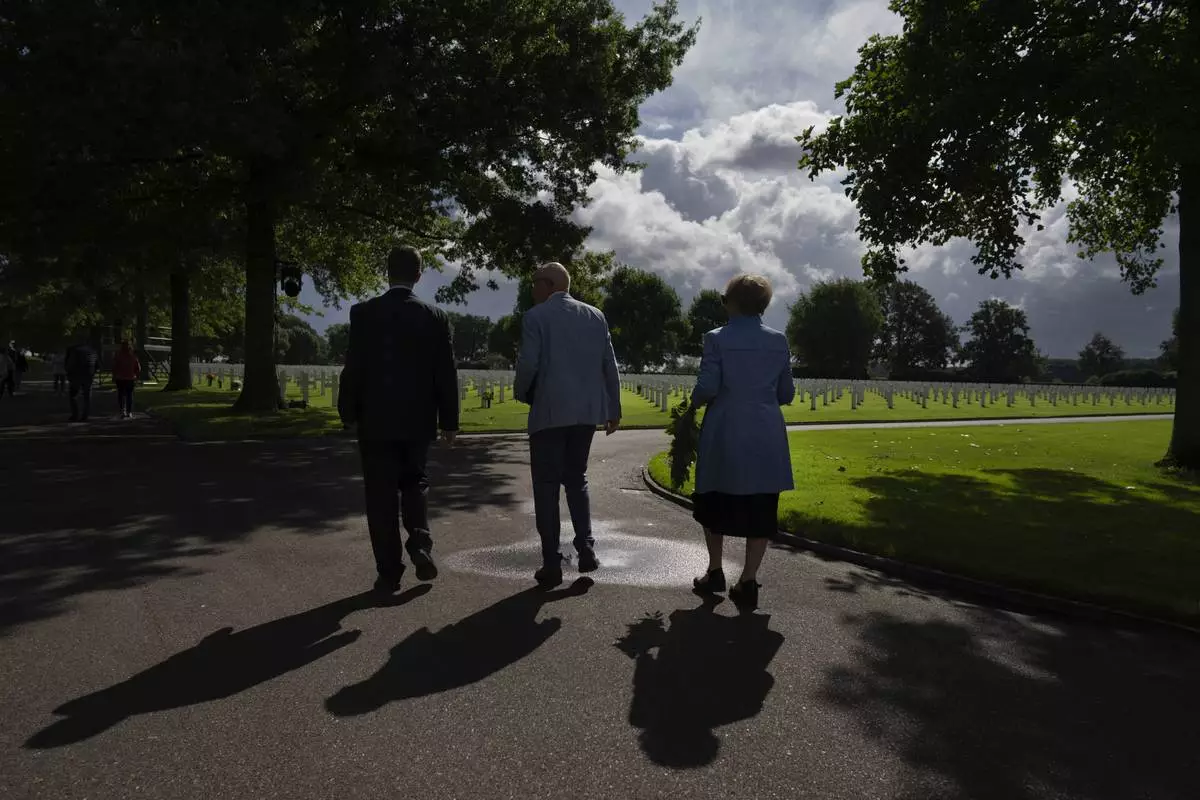
Eighty years after the liberation of the south of the Netherlands, Scott Taylor, left, Ton Hermes, center, and Maria Kleijnen walk to the grave of Scott's grandfather Second Lt. Royce Taylor, a bombardier with the 527 Bomb Squadron, at the Netherlands American Cemetery in Margraten, southern Netherlands, on Wednesday, Sept. 11, 2024. (AP Photo/Peter Dejong)
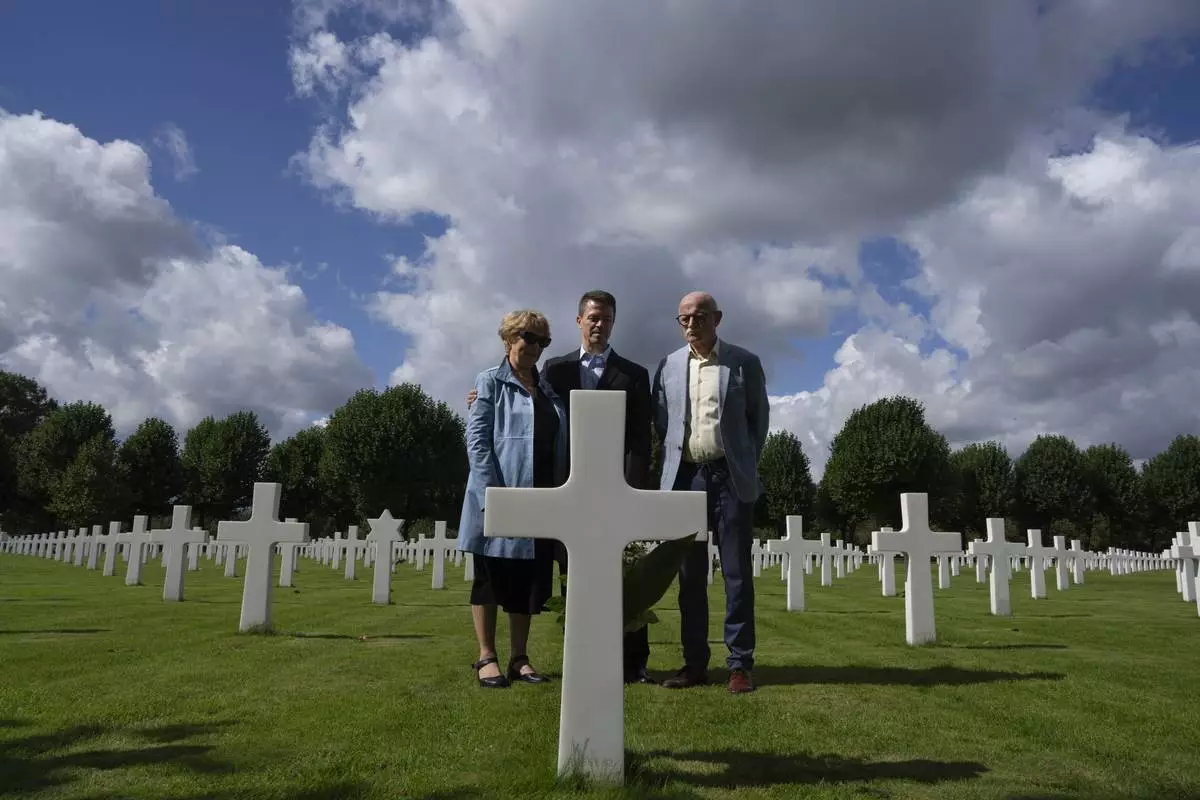
Eighty years after the liberation of the south of the Netherlands, Scott Taylor, center, Ton Hermes and Maria Kleijnen stand next to the grave of Scott's grandfather Second Lt. Royce Taylor, a bombardier with the 527 Bomb Squadron, at the Netherlands American Cemetery in Margraten, southern Netherlands, on Wednesday, Sept. 11, 2024. (AP Photo/Peter Dejong)
AVIGNON, France (AP) — A 71-year-old French man admitted in court Tuesday that for nearly a decade, he repeatedly drugged his unwitting wife and invited dozens of men to rape her while she lay unconscious in their bed.
His wife of 50 years, who has divorced him since his arrest, also got to speak, telling the court that she feels completely betrayed.
In a trial that has gripped France and raised awareness about sexual violence in the home and beyond, Dominique Pélicot told the court that he also raped his wife, Gisèle Pélicot, and that the 50 men standing trial alongside him understood exactly what they were doing.
“Today I maintain that, along with the other men here, I am a rapist,″ Dominique Pélicot testified. “They knew everything. They can’t say otherwise.”
Pélicot’s testimony marked the most important moment yet in a trial that has shocked the world. Although he previously confessed to investigators, his court testimony will be crucial for the panel of judges to decide on the fate of his co-defendants, who range in age from 26 to 74. Many of them deny having raped Gisèle Pélicot, saying her then-husband had manipulated them or that they believed she was consenting.
Many following the case also hope his testimony might help explain why Dominique Pélicot would subject the mother of his three children to such unconscionable abuse.
Gisèle Pélicot has become a hero to many rape victims and a symbol of the fight against sexual violence in France for agreeing to waive her anonymity in the case, letting the trial be public and appearing openly in front of the media. She shows up every day, passing through the courthouse security line behind men accused of raping her. As she left court during a break Tuesday, supporters brought her flowers.
After days of delay due to what his lawyers said was a kidney stone and urinary tract infection, Dominique Pélicot, seated in a wheelchair, testified that the charges against him are true. With his ex-wife looking on from the packed gallery and his voice trembling and barely audible at times, he started a long day of testimony trying to explain childhood traumas that he said scarred and molded him into the person he became.
“One is not born a pervert, one becomes a pervert,” Pélicot told the judges after recounting, sometimes in tears, being raped by a male hospital nurse at age 9 and being forced to take part in a gang rape at age 14.
Pélicot also said that for years, his father sexually abused a young girl his family had taken in, and that his brother later said their father had invited other men to do the same.
He regretted that his parents didn't let him continue his studies after he turned 14. He said that around that time, he tried to persuade his mother to leave the house with him, but “she never wanted to.”
“I don’t really want to talk about this, I am just ashamed of my father. In the end, I didn’t do any better,'' said Pélicot, who faces 20 years in prison if convicted.
After he spoke about his difficult upbringing, Gisèle Pélicot was given the opportunity to address the court.
“It is hard for me to hear this. For 50 years, I lived with a man. I couldn’t imagine even one second that he could have committed acts of rape,″ she said. “I trusted this man entirely.″
The two looked at each other, him from behind the dock’s glass window and her from the witness stand.
“I am guilty,” he told her. “I regret everything I did. I ask you for forgiveness, even if it is unpardonable.”
Asked if she wanted to respond, Gisèle Pélicot turned and left the stand.
When asked about his feelings toward his ex-wife, Dominique Pélicot said she didn't deserve what he did.
“From my youth, I remember only shocks and traumas, forgotten partly thanks to her,” he said in tears.
At that moment, Gisèle Pélicot put on her sunglasses.
Later, Dominique Pélicot said, “I was crazy about her. She replaced everything. I ruined everything.”
A supermarket security guard caught Pélicot in 2020 secretly shooting video up women’s skirts, according to court documents. During a search of his house and electronic devices, police found thousands of photos and videos of men engaging in sexual acts with Gisèle Pélicot while she appeared to be unconscious in bed.
With the recordings, police were able to track down most of the 72 suspects they were seeking, but not all.
In addition to the photos and videos of Gisèle Pélicot, investigators found photos of the Pelicots' daughter, Caroline Darian, and two daughters-in-law that were surreptitiously taken while they were in their underwear, getting undressed or taking showers, according to authorities.
While her mother has stayed remarkably calm throughout the trial, Darian walked out of the courtroom Tuesday as her father was being asked about photos of her that were found on his laptop.
″Excuse me, I’m going to vomit,″ she said angrily before rushing out. She has written a book about what happened to her family, called ″And I Stopped Calling you Daddy.″
After retiring, the Pélicots moved from the Paris region to a house in Mazan, a small town in the Provence region.
When police officers called Gisèle Pélicot in for questioning in late 2020, she initially told them her husband was “a great guy,″ according to legal documents. They then showed her some photos. She left and later divorced her husband.
Since Dominique Pélicot’s arrest, other cases have surfaced. He was fined after being caught shooting video of a women’s crotch in 2010 and required to see a psychologist. Gisèle Pélicot has said she never knew about this incident.
Under French law, the proceedings inside the courtroom cannot be filmed or photographed. Dominique Pélicot has been brought into the court through a special entrance that's inaccessible for the media, because he and some other defendants are being held in custody during the trial and can't be filmed. Defendants who are not in custody have been arriving at the courthouse wearing surgical masks or hoods to avoid having their faces filmed or photographed.
Among those hoping to secure a seat to watch the Tuesday's proceedings was Bernadette Tessonière, a 69-year-old retiree who lives a half-hour drive from Avignon, where the trial is taking place.
“How is it possible that in 50 years of communal life, one can live next to someone who hides his life so well? This is scary,” she said.
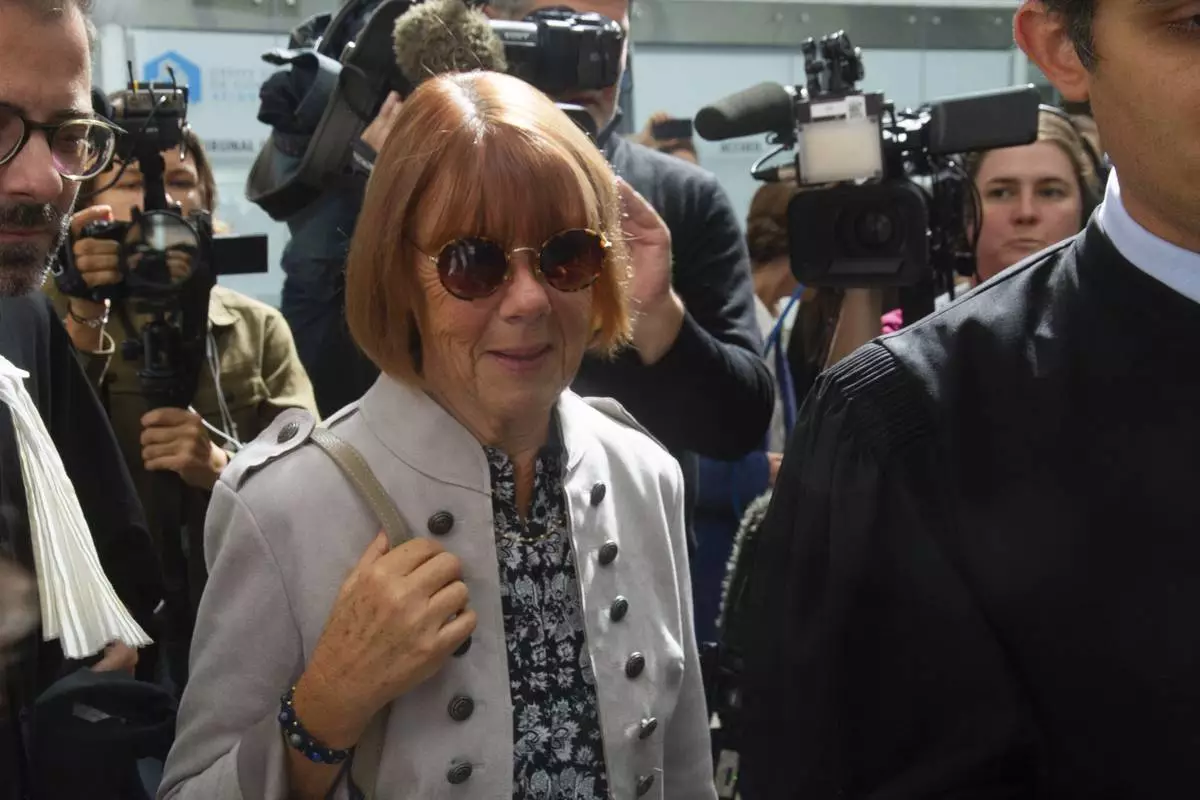
Gisele Pelicot arrives at the Avignon court house, in Avignon, southern France, Tuesday, Sept. 17, 2024. Her ex-husband admitted in court that for nearly a decade, he repeatedly drugged his unwitting wife and invited dozens of men to rape her while she lay unconscious. (AP Photo/Diane Jantet)

Gisele Pelicot arrives at the Avignon court house, in Avignon, southern France, Tuesday, Sept. 17, 2024. Her ex-husband admitted in court that for nearly a decade, he repeatedly drugged his unwitting wife and invited dozens of men to rape her while she lay unconscious. (AP Photo/Diane Jantet)
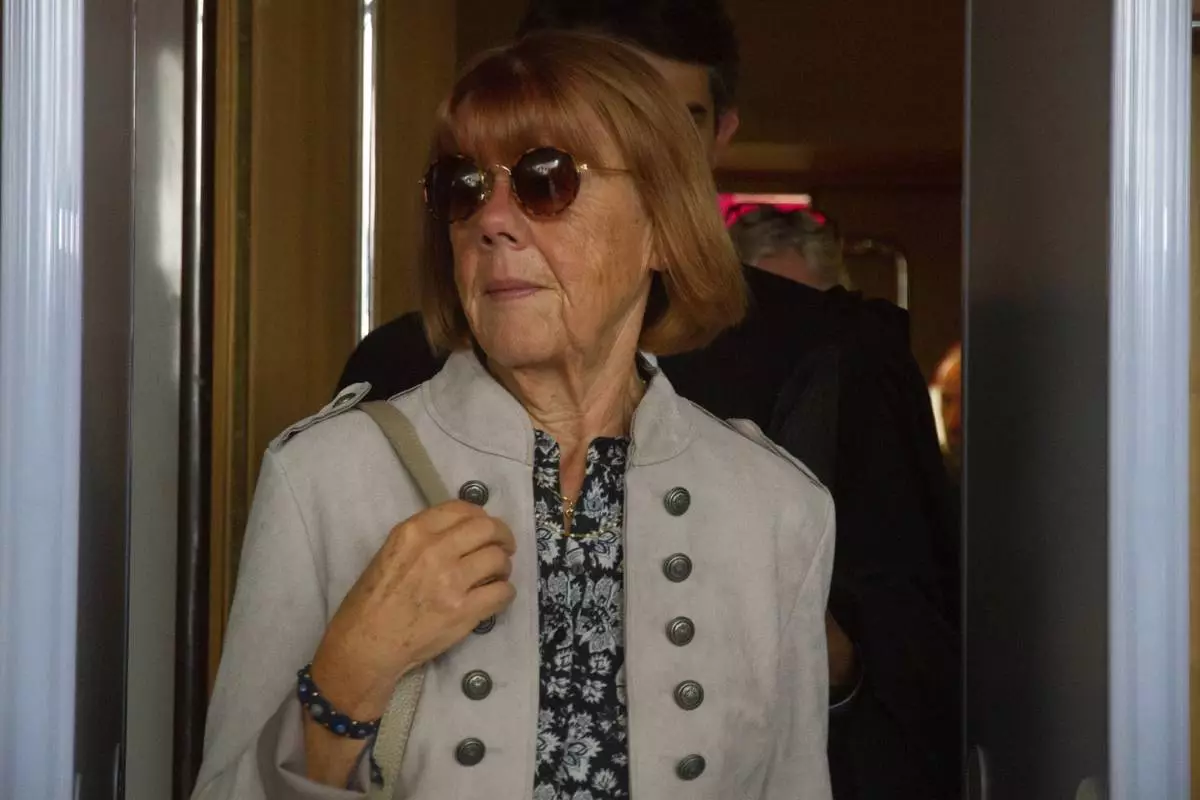
Gisele Pelicot exits the Avignon court house, in Avignon, southern France, Tuesday, Sept. 17, 2024, after her ex-husband admitted in court that for nearly a decade, he repeatedly drugged his unwitting wife and invited dozens of men to rape her while she lay unconscious. (AP Photo/Diane Jantet)
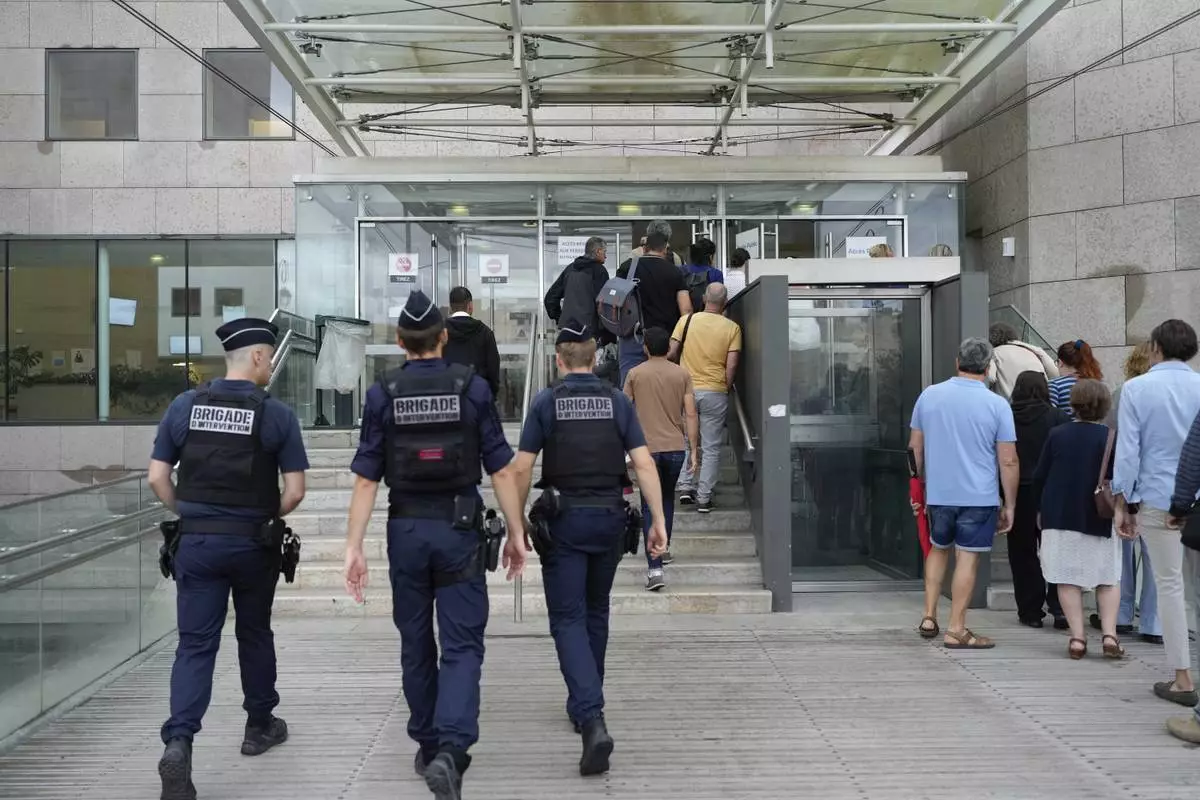
FILE - Police officers walk in the Avignon court house prior to the trial of Dominique Pelicot, in Avignon, southern France, Thursday, Sept. 5, 2024. (AP Photo/Lewis Joly, File)

FILE - Gisele Pelicot speaks to media as she leaves the Avignon court house, southern France, Thursday, Sept. 5, 2024. (AP Photo/Lewis Joly, File)
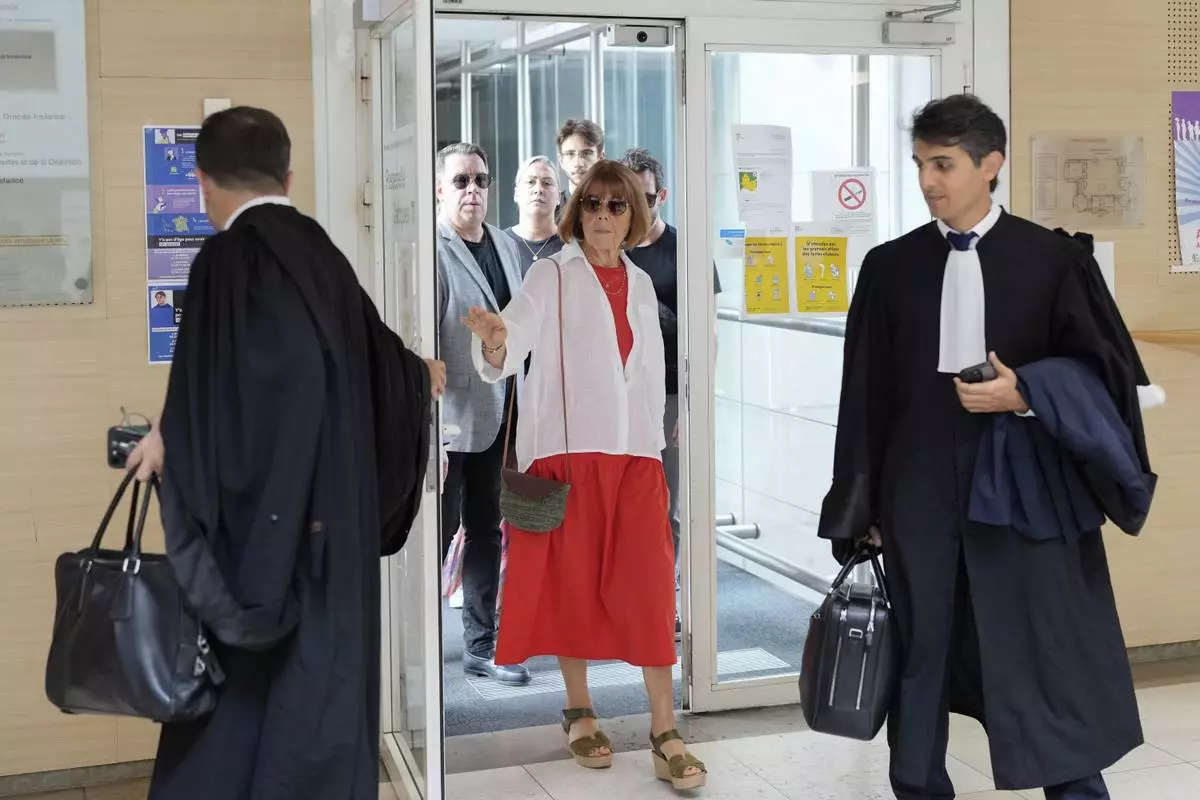
FILE - Gisele Pelicot, left, arrives in the Avignon court house, in Avignon, southern France, Thursday, Sept. 5, 2024. (AP Photo/Lewis Joly, File)
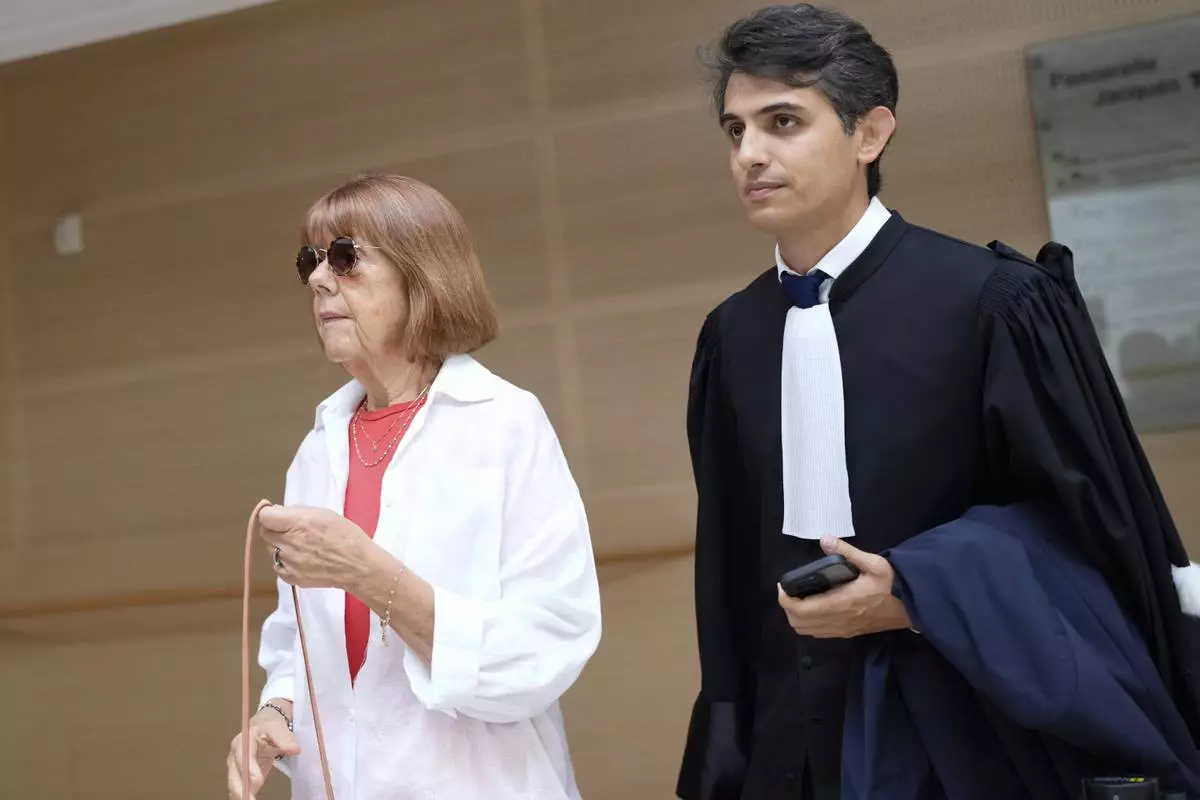
FILE - Gisele Pelicot, left, arrives in the Avignon court house, in Avignon, southern France, Thursday, Sept. 5, 2024. (AP Photo/Lewis Joly, File)















